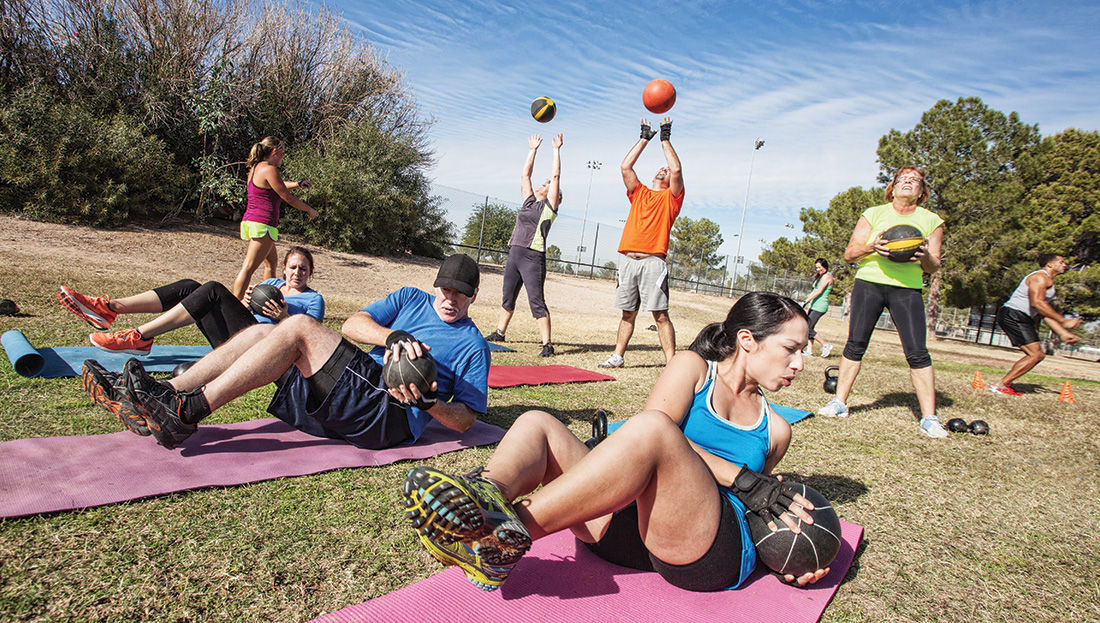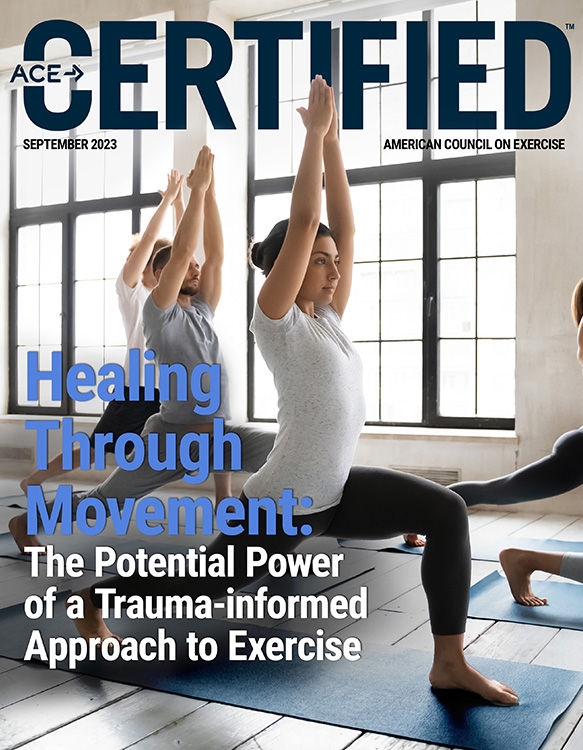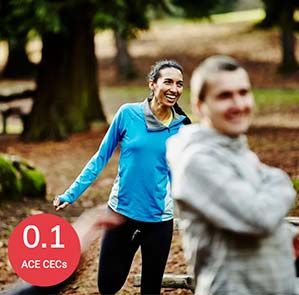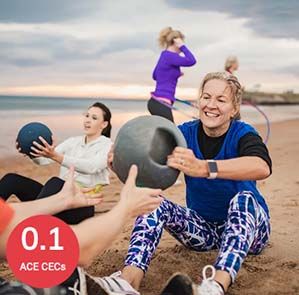
Whenever she leads one of her boot camps in Manhattan’s Riverside Park, personal trainer Karen Katz gets noticed. Maybe it’s her effervescent, upbeat personality. Maybe it’s the sign (“Karen Katz Fitness”) with the QR code that she sets up near her staging area—an 80-foot-long terrace along the park’s 19th century stone walls. Maybe it’s her classes of 16 or so, mostly women, who move with impressive energy and fluidity through the workout.
Regardless, she says, passersby—walking their dogs or jogging along the network of paved and dirt paths that snake through this four-mile-long, New York City park overlooking the Hudson River—will invariably stop when they see Karen’s class. And they’ll ask the same questions.
“Hey, when did you start doing this?”
“About three years ago,” she replies.
“Are you only in the summer?”
“Nope, we’re out here year round,” she responds. “Even in the winter.”
That wasn’t Katz’s intention when she started holding the outdoor camps in April 2020. A long-time gym-based instructor (she worked for the NYC fitness guru David Barton), Katz envisioned her outdoor boot camp classes as a temporary measure. Public parks were open for limited use in New York during the pandemic, so when her gym closed, she pivoted to this nearby alternative.
“I posted on a local Mom’s Facebook group,” she recalls. “I said I’d be holding masked, socially distanced classes in the park.”
The response? She chuckles as she responds: “I had so many people show up I had to bring a megaphone for everyone to hear me, with the social distancing.”
Among those who noticed was Audrey Dursht, a resident of Manhattan’s Upper West Side. After her gym closed during the lockdown, Dursht had begun taking long walks in Riverside Park for exercise, accompanied by her friend and neighbor Lila Locksley. They saw Karen’s class and were intrigued.
“We were looking for something more challenging and figured we’d try it,” recalls Dursht. She and Locksley enjoyed it from the get-go. “Karen is quite gifted as an instructor. She pays attention, she manages a class well, and while it was challenging, she also keeps it light and makes it fun.”
And, adds Dursht, she learned that there is something very special about exercising outdoors. “I loved being outside,” she says. “It brought a whole different dimension to my training.” So much so that, even after the most stringent pandemic measures were lifted and indoor facilities were reopened, Dursht and Locksley decided to stick with boot camp in Riverside Park. “I didn’t like the idea of going back to a gym every day,” she explains.
Neither did Katz.
Using word of mouth and social media, Katz had built up quite a following for her classes—a 45-minute combination of cardio, strengthening and conditioning movements, using bands and body weight as resistance. Still, as long as the size of her group didn’t exceed 20, she didn’t need a permit from the New York City Parks Department. And she’s responsible and conscientious: the areas in the park where she holds her classes are left clean when she’s done. Bands are collected, mats are folded up—it’s like a class at a neat and tidy health club. Except, well…it’s not in a club. And Katz has no intention of returning to such a place. “Once I started doing my own thing out here, I realized I could never go back,” Katz says. “We’d lose something unique.”
Are you an ACE Certified Professional interested in obtaining your own shared-use agreement to work in a public space? Use the button at the top of this page to access your ACE Pro Only Bonus Tool for a complete toolkit for steps on how to obtain a shared use agreement and resources to help make it a reality.
The Weather Factor
As a trainer, Katz got out—and stayed out. Other trainers who, like Katz, went outside by necessity have remained there, at least part of the time, by choice.
“I had to do it,” says Bob Phillips, talking about the dark days of March 2020 as he, like many trainers, saw their livelihoods come to a sudden halt. What to do? “If I’d had a sizable amount of people that I could take online and not lose my business, I would have done that. But I did not have a real Zoom-able bunch of clients. I had to figure what else I could do. Going outside was my only option.”
But in the early spring of 2020, even many suburban parks were closed, including those in his Melville neighborhood, which is a suburb of Long Island, NY. Phillips scoured his suburban neighborhood until he found one place that was open. It was a small county park, with several baseball fields and some scratchy patches of grass. “Technically it was a park, but it was actually more like a parking lot,” he says with a laugh. Still, the fencing around the ball fields and the bleachers was sufficient to attach bands and a TRX. Phillips would bring along kettlebells and a BOSU balance trainer, as well.
He contacted his clients, inviting them to meet him outside for small-group training. While some of his older clients were still hesitant to leave their homes, many—tired of being stuck inside— responded affirmatively and, like Dursht in the city, found that exercising outdoors—even in a rather rundown park/parking lot—was a whole new ball game. By the summer of that year, Phillips had three groups of three to four clients and a couple of solo clients that he was meeting outside. And soon, he was able to move to a larger park with better facilities.
Still, the whole idea of moving his business outdoors, even temporarily, was an adjustment. “All of a sudden,” he says, “weather…something you never thought about when you trained people in a gym or their homes…became a huge factor.”
Phillips had to pace his clients (and himself) in the sweltering humidity and heat of summer; and as the outdoor workouts continued into early 2021, he had to contend with cold temperatures that sometimes forced last-minute class cancellations.
But there were benefits. “I think you become hardier training outdoors,” he argues, using a word often associated with plants that survive the winter. “You have to embrace variables that aren’t as controllable when you’re outside and you learn to adapt to them.”
Some health and exercise professionals incorporated outdoor exercise options as part of a broader package of offerings to clients. At Providence FitBody Boot Camp in Rhode Island, owner Matt Espeut scrambled to keep his members engaged, even when he was forced to temporarily close the doors of his facility during the lockdown in the spring of 2020.
“We pivoted right away and went to Zoom,” says Espeut. “But we also held some challenges, things our clients could engage with, and we ran some forums and discussion groups every week. We even had virtual wine socials on Zoom. We just wanted to keep our members fully engaged and justify still charging their memberships.”
Espeut also ramped up the gym’s social media footprint, spotlighting member achievements in a “Transformation Tuesday” feature on Facebook.
But not all his efforts involved looking at a screen. Espeut also saw the value of taking his offerings outdoors for special occasions, such as his July 4th Parking Lot Beat Down. “We take 50-plus members and have a great workout,” he explains. And, in keeping with the idea of the occasional outdoor workout to spice up an exercise regimen, “we have a FitBody Field Trip. About a hundred members do a hike together in a local park and afterwards we all go have coffee.”
While different than Katz or Phillips’ regularly scheduled outdoor workouts, Espeut’s forays outside of the gym show that taking workouts outdoors doesn’t have to be an all-or-nothing proposition. Rather, he says, outdoor opportunities, “help deliver client satisfaction, and that’s the best advice I can give. You need to focus on the member or the client, not the dollar signs. Caring for your clients is the number one principle. We try to make their time with us the best 30 minutes of their day.”
A Boost to Your Bottom Line
Karen Katz’s 45-minutes classes have been good for her boot-camp participants, and not bad for her bank account either.
Over the past three years, she has held, on average, three to five classes in the park every week. Members book online in advance, paying $25 a class. This past summer, as Katz began coursework for a master’s degree in education, she offered her classes on weekends. Here again, the outdoor training provides an advantage. “The outdoor classes give me a lot of time flexibility,” she explains.
Phillips hasn’t returned to the gym either. Eventually, most of his in-home clients opened their doors to him again. And yet his outdoor workouts continue—only once or twice a week now.
It is as much for his enjoyment, he admits, as it is for his clients.
“I discovered something that I never would have found if COVID hadn’t hit,” he says. “I love the outdoor training. I still do it occasionally myself. And one of our weekly groups still meets every Wednesday morning. It’s not any real sizable part of my business. It’s just a few of my oldest clients, and they really enjoy it.”
Katz, too, recognizes that her pandemic pivot led to something new and significant in her career. “I would have never dreamed that I’d be doing my training outside of the gym,” she says. “But now I really don’t want to go back.”
The Many Benefits of Green Exercise
Awe. Fun. Friendship.
Those are the three words that endurance coach Travis Macy lists as the benefits of outdoor training. Macy, who grew up in the mountains of Colorado and has competed at an elite level in high-altitude, ultra-distance running, bike and ski races around the world, does most of his training outside.
He thinks you should consider doing the same—for your clients and yourself.
“The awe of being in nature and seeing it up close…whether it’s in the Rocky Mountains or Central Park…is very good for mental health,” he says. “I would argue that by doing exercise outdoors, you’re getting more bang for your buck, because you’re getting all the health benefits of exercise that we know of, and you’re having this soul-lifting natural experience as well.”
Several studies have suggested the added benefits of green exercise. A 2013 study, for example, found that participation in outdoor exercise altered the perception of effort. “The nature element may help achieve a greater intensity of exercise without perception of effort changing,” according to the authors of the study, which appeared in the journal Extreme Physiology and Medicine. “If a person perceives exercise to be easier, it has the potential to be more enjoyable.” And enjoyment of exercise often leads to greater adherence.
There’s another argument for outdoors exercise that is a little harder to measure but simpler to state: “Being outside is fun,” says Macy, who has also authored two books, the most recent of which is A Mile at a Time: A Father and Son’s Inspiring Alzheimer’s Journey of Love, Adventure and Hope by Travis and Mark “Mace” Macy with Patrick Regan. “And fun is something I try to tap into for everyone I coach. Fun leads to consistency and sustainability and that’s what really leads to fitness.”
For veteran trainer Bob Phillips, the socialization aspect of outdoor exercise was critical for some of his clients, especially during the pandemic. “The social part alone was so key,” says Phillips, who started holding outdoor boot-camp classes during the lockdown. “It kept some of my clients from drifting away from fitness completely. They came back to the outdoor class because they didn’t want to lose connection with the group they enjoyed training with.”
Finally, Macy points out that the pursuit of group physical activity outdoors is hardly a new concept. “When I travel to Asia, these outdoor group exercise classes seem to be part of the culture,” he says. “I remember one night in Thailand, I saw about a hundred people in an outdoor park doing tai chi with an instructor. So, it’s kind of a time-tested idea.”
Expand Your Knowledge
Shared-Use Agreements for Outdoor Fitness
Learn from a panel of experts on how shared-use agreements can make it possible for you to deliver physical activity and exercise programs in parks and other public spaces. Designed for health and exercise professionals and physical activity advocates, this course covers the basic advocacy tenants and best practices for these types of permits.
Establishing a Successful Outdoor Fitness Business
Covering all aspects of outdoor fitness, including marketing, legal issues around park usage, waivers, insurance and class design formats that are inclusive for all fitness levels, this video training provides you with a checklist for getting your outdoor business started and keeping it thriving.





 by
by 




